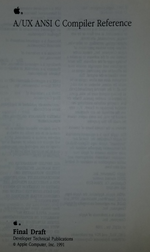You need a DIY Book Scanner
That web page doesn't work. Clicking on "Getting Started" brings up an error message and does not continue?
You need a DIY Book Scanner
Loads https://www.diybookscanner.org/en/intro.html here, except no pictures…That web page doesn't work. Clicking on "Getting Started" brings up an error message and does not continue?
This person is me. Just like the OP, I am especially interested in information about building A/UX device drivers.I realized that the book is separate. Sorry. I did find this GitHub where a person is trying to find all documentation for A/UX:

A/UX Manuals and Software
A/UX Manuals and Software. GitHub Gist: instantly share code, notes, and snippets.gist.github.com
Please let me know if there is any way I can help with the preservation of these documents.I found some A/UX Development docs today (loose-leaf version) and the 1.0b development tools disk. Probably enough for someone to do some damage.
That’s great. Could you please say if your development documents include “A/UX Device Drivers Kit” and/or “Building A/UX Device Drivers”?Some progress -- I got an external CD-ROM drive to rip the disk .iso.


I can confirm A/UX already works with BlueSCSI and Macintosh II series computers like the SE/30. A/UX‘s complicated startup procedure is due to the fact that the Macintosh ROM was not intended to load anything else than a Macintosh System file on a HFS volume. The A/UX kernel however is on an Unix volume. To load the UNIX kernel without a MacOS based bootloader, you would need to eitherMmm cool! What about a dual boot thing to use BlueSCSI and choose which way to go; System 7 or AU/X and have fun on the SE/30 or a Mac II?
Do it like early Mac OS X version and add a dummy System Folder to the disk. You would need a small HFS volume for this which holds the kernel and dummy System Folder.

Go and start codingYep. Put each OS on separate volumes. With @Kay K.M.Mods' new SMC ROM SIMM, the ROM can be programmed in assembly from C to bring up a bootloader like this on my Mac Mini G4. This is an example; I would see two HDD icons rather than a CD/DVD icon.

